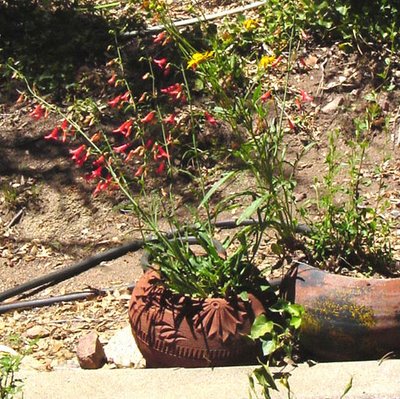"Do you know where I could get seed for single hollyhocks?" The clerk, toting up my overly ambitious purchases at
Flagstaff Native Plants last summer, added, "I've had several inquiries lately."
"Not in commercial quanitities." I told her I had a small collection of seed at home which had started gardens in Texas and a couple of Arizona towns, as well. Seed I had gathered walking the older neighborhoods of Prescott where you can't miss the hollyhocks at this time of year.
What I didn't know at the time was that
finally a commercial seed company was again packaging single hollyhock seed. None other than Burpee, the gold standard for gardeners.
And available at Wal-Mart, at that.
For years, the only plants or seeds available commercially have been the overly bred, fancy, fluffy doubles. Attributable, no doubt, to an American mind-set that goes for giant radishes and "blossoms as big as saucers."
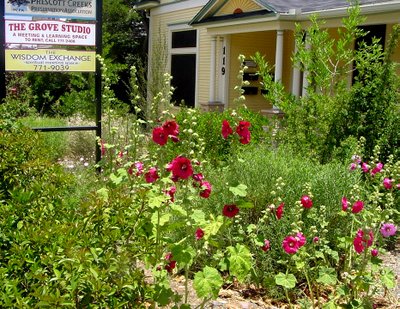
Interest in the old-fashioned kind of flower might be attributed to the current fad of
down-home chic that we suffer as comfortable old-time Western towns are repurposed (suitable, that horrid word!) into boutique mountain towns.
But in my better moments, I credit it to the plants' beauty. After all, what other flower can get made into a
pretty little doll so easily?
If there were to be a vote, I'd choose the hollyhock as Prescott's civic flower! It's settled in and happy in our climate -- and is especially suited to the local Victorians, such as the Grove studio (above) on, yes, Grove St. or the buildings on the Sharlot Hall grounds.
You'll find old-fashioned single hollyhocks growing all around the older section of town. I suspect the reason is that over on Grove St., down on Granite, in many alleys and elsewhere, the hollyhocks are the next thing to wild.
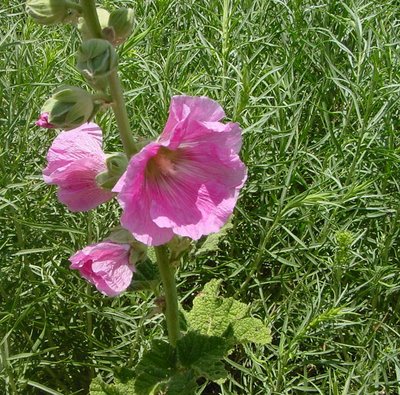
(Don't forget, there are native Arizona plants that are close cousins to the hollyhock. Bright apricot to orange
globe mallows that grace the roadsides from Prescott all the way down to The Valley. And at higher elevations, near permanent water sources, delicate pink
checker mallows.)
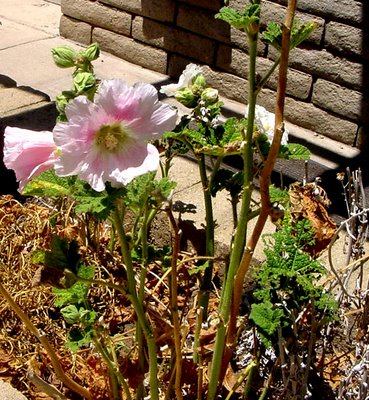
Hollyhocks are amazingly persistent. That thriving plant above is in among other species dried up because the drip system hasn't been delivering. The plant below comes up every year right at the street on Park Avenue. (This year of serious drought is the first time I've seen it give up completely. The leaves are brown and on their way to dust.)
Even when the soil covers our basic granite only a couple of inches deep, the hollyhocks really try! I've got a plant, several years old, which has found (or made) a crack in the stone; it comes up every year, may get as high as 8 inches, opens a blossom or two and produces a single seed pod before the frost nips it. There's one median strip on west Gurley where the property owner keeps mowing; when I last counted, there were 27 hollyhock plants trying their damndest to grow up. Most have been there several years.
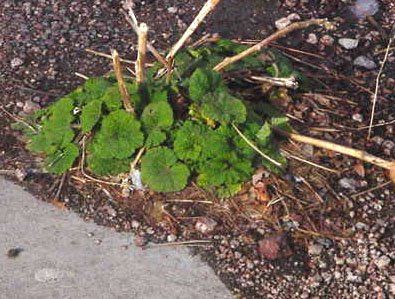
Even the formerly Valley National, formerly BankOne, now Chase bank on Gurley has its own hollyhock (below), if the maintenance people don't discover it before it blooms!
And I noticed that down along the bank of Granite Creek at the mural below the Bank of America, there are a couple of hollyhocks. I think you can thank me -- I made a point of scattering seeds down there several years in a row. Or was it columbine seeds?

Even if the more stiff-necked tidiers manage to corral all the downtown hollyhocks and make them behave, there are still some more-laid-back business folk who don't mind if a flower or two (or several) jump the bounds of the planter and make themselves comfortable right at the sidewalk. Long may they live and prosper.

 You may recall that this spring, frustrated by my attempts to grow datura from seed, I bought a seedling up at Flagstaff Native Plant & Seed. Pragmatic, yes. Nonetheless, a defeat -- after all, the plant grows wild in my immediate neighborhood and I've collected plenty of seed over the years. In any event, the seedling has prospered and is now a largish plant. Big enough to produce one blossom this summer and possibly many more in the years ahead.
You may recall that this spring, frustrated by my attempts to grow datura from seed, I bought a seedling up at Flagstaff Native Plant & Seed. Pragmatic, yes. Nonetheless, a defeat -- after all, the plant grows wild in my immediate neighborhood and I've collected plenty of seed over the years. In any event, the seedling has prospered and is now a largish plant. Big enough to produce one blossom this summer and possibly many more in the years ahead. Here is the large bud, looking like a candlestick.
Here is the large bud, looking like a candlestick. The blossom has emerged and is thinking of uncoiling.
The blossom has emerged and is thinking of uncoiling. I waited patiently the evening that the flower was to open; there was only a small amount of movement. I had once before caught a datura blossom as it suddenly sprang open at dusk. A wonderful sight -- and wonderful scent, as well, like many night blooming plants. This particular night, I lost patience, figuring that I could photograph the open flower the next morning.
I waited patiently the evening that the flower was to open; there was only a small amount of movement. I had once before caught a datura blossom as it suddenly sprang open at dusk. A wonderful sight -- and wonderful scent, as well, like many night blooming plants. This particular night, I lost patience, figuring that I could photograph the open flower the next morning. Hah! No such luck -- in the morning, the blossom was spent!
Hah! No such luck -- in the morning, the blossom was spent! I had to make do with another plant just up the street from me -- a plant that has grown wild by the roadside for several years, with neither watering nor other TLC.
I had to make do with another plant just up the street from me -- a plant that has grown wild by the roadside for several years, with neither watering nor other TLC. Developing seed pods on the nearby plant; my own datura has one healthy seed pod. Easy to see why the name thorn apple. Other names for the plant include jimson weed, gypsum weed, loco weed, jamestown weed, angel's trumpet, devil's trumpet, devil's snare, according to Wikipedia. It is found in almost every state and belongs to the solanaceae family, which includes everything from belladonna to tomatoes, potatoes, chilis, tobacco and deadly nightshade.
Developing seed pods on the nearby plant; my own datura has one healthy seed pod. Easy to see why the name thorn apple. Other names for the plant include jimson weed, gypsum weed, loco weed, jamestown weed, angel's trumpet, devil's trumpet, devil's snare, according to Wikipedia. It is found in almost every state and belongs to the solanaceae family, which includes everything from belladonna to tomatoes, potatoes, chilis, tobacco and deadly nightshade. BTW, I found this reproduction from Georgia O'Keefe among my pictures. Not only beautiful, the datura is seductively dangerous. "Most parts of the plant contain atropine, scopolamine, and hyoscyamine. It has a long history of [medicinal and magical] use both in S. America and Europe and is known for causing delerious states and poisonings in uninformed users," notes the Erowid Organization, whose pages are concerned with hallucinogenic plants. There is, of course, also an association of fanciers and breeders, the American Brugmansia & Datura Society. For the record, brugmansia is the name given to tree daturas, native to South America.
BTW, I found this reproduction from Georgia O'Keefe among my pictures. Not only beautiful, the datura is seductively dangerous. "Most parts of the plant contain atropine, scopolamine, and hyoscyamine. It has a long history of [medicinal and magical] use both in S. America and Europe and is known for causing delerious states and poisonings in uninformed users," notes the Erowid Organization, whose pages are concerned with hallucinogenic plants. There is, of course, also an association of fanciers and breeders, the American Brugmansia & Datura Society. For the record, brugmansia is the name given to tree daturas, native to South America.


